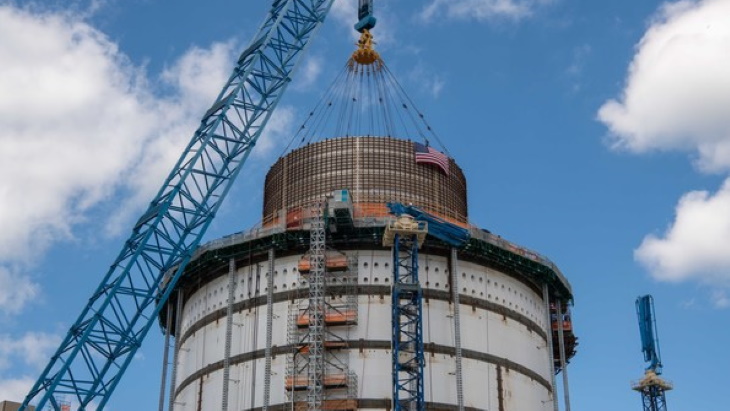Tests that simulate the temperatures and pressures which the reactor systems will be subjected to during normal operation have been started at unit 3 of the Vogtle plant near Waynesboro, Georgia. Meanwhile, the final module has been put in place at unit 4, marking the last major crane lift at the project site.

The final module being put in place at Vogtle 4 (Image: Georgia Power)
Georgia Power today announced that hot functional testing had begun at unit 3. These tests involve increasing the temperature of the reactor coolant system and carrying out comprehensive tests to ensure that coolant circuits and safety systems are operating as they should. Carried out before the loading of nuclear fuel, such testing simulates the thermal working conditions of the power plant and verifies that nuclear island and conventional equipment and systems meet design requirements.
"Over the next several weeks, nuclear operators will use the heat generated by the unit's four reactor coolant pumps to raise the temperature and pressure of plant systems to normal operating levels," the company said. "Once normal operating temperature and pressure levels are achieved and sustained, the unit's main turbine will be raised to normal operating speed using steam from the plant. During these series of tests, nuclear operators will be able to exercise and validate procedures as required ahead of fuel load."
Georgia Power said the hot functional testing of Vogtle 3 will be completed in six to eight weeks.
Cold functional tests - which are carried out to confirm whether components and systems important to safety are properly installed and ready to operate in a cold condition - were completed at Vogtle 3 on 19 October last year. The main purpose of those tests was to verify the leak-tightness of the primary circuit.
The first nuclear fuel assemblies for unit 3 arrived at the Vogtle site in December.
Final module in place
Georgia Power also announced that a 750,000 gallon (2.8 million litre) water tank has been lifted into place atop the unit 4 containment vessel and shield building roof. The CB-20 module is a major part of the Westinghouse AP1000 reactor's advanced passive safety system. The component is 35 feet (10.6 metres) high and weighs over 720,000 pounds (326 tonnes). Part of the plant's passive safety systems, it will hold water to help cool the reactor in an emergency. The water can also be directed into the reactor's used fuel pool, while the tank itself can be refilled from water stored elsewhere on site.
The modules used for Vogtle units 3 and 4 were made in advance of their arrival at the site, where they would be assembled into larger components that make up the nuclear units. Since 2011, major modules were delivered to the site by rail and truck and included a range of plant components, such as floor and wall sections and supporting structures that surround the containment buildings and reactor vessels.
The final major module arrived in late 2019, meaning all 1485 major modules required to complete construction had been manufactured and safely delivered.
Construction of Vogtle unit 3 began in March 2013 and unit 4 in November the same year. Southern Nuclear and Georgia Power, both subsidiaries of Southern Company, took over management of the construction project in 2017 following Westinghouse's Chapter 11 bankruptcy. Georgia Power expects to meet the November 2021 and November 2022 regulatory-approved in-service dates for units 3 and 4, respectively.
Researched and written by World Nuclear News